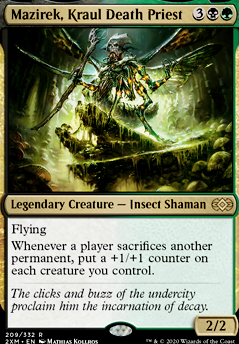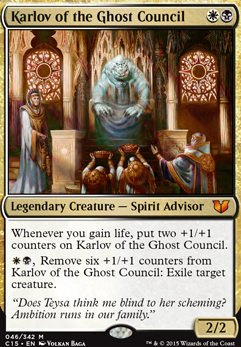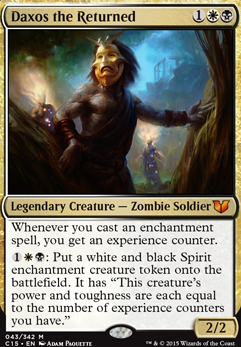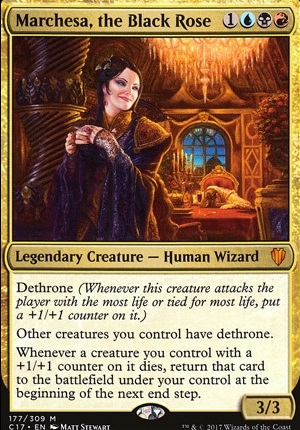
Mazirek, Kraul Death Priest Shenanigans
Commander / EDH Aggro BG (Golgari) Combo Counters Infinite Combo Multiplayer
Creature (27)
- 1x Abhorrent Overlord
- 1x Avenger of Zendikar
- 1x Burnished Hart
- 1x Disciple of Bolas
- 1x Endrek Sahr, Master Breeder
- 1x Eternal Witness
- 1x Fertilid
- 1x Flesh-Eater Imp
- 1x Fleshbag Marauder
- 1x Genesis
- 1x Ghoulcaller Gisa
-
1x
Grave Titan

- 1x Greenwarden of Murasa
- 1x Korozda Guildmage
- 1x Mycoloth
- 1x Nether Traitor
- 1x Puppeteer Clique
- 1x Rune-Scarred Demon
- 1x Sakura-Tribe Elder
- 1x Sidisi, Undead Vizier
- 1x Smothering Abomination
- 1x Solemn Simulacrum
-
1x
Titania, Protector of Argoth

- 1x Ulamog, the Infinite Gyre
-
1x
Viscera Seer

- 1x Woodfall Primus
- 1x Yavimaya Elder
Land (34)
- 1x Ancient Tomb
- 1x Bayou
- 1x Blighted Woodland
- 1x Bloodstained Mire
- 1x Command Tower
-
6x
Forest

- 1x Gaea's Cradle
- 1x High Market
- 1x Llanowar Wastes
- 1x Marsh Flats
- 1x Misty Rainforest
-
1x
Overgrown Tomb

- 1x Petrified Field
- 1x Phyrexian Tower
- 1x Polluted Delta
- 1x Shizo, Death's Storehouse
-
5x
Swamp

- 1x Twilight Mire
- 1x Urborg, Tomb of Yawgmoth
- 1x Verdant Catacombs
- 1x Volrath's Stronghold
- 1x Wasteland
- 1x Windswept Heath
- 1x Wooded Foothills
- 1x Yavimaya Hollow
Enchantment (8)
- 1x Awakening Zone
- 1x Bitterblossom
- 1x Evolutionary Leap
- 1x From Beyond
- 1x Grave Pact
- 1x Phyrexian Arena
- 1x Survival of the Fittest
- 1x Sylvan Library
Artifact (8)
Instant (7)
- 1x Beast Within
- 1x Chord of Calling
- 1x Go for the Throat
- 1x Harrow
- 1x Krosan Grip
- 1x Putrefy
- 1x Vampiric Tutor
Sorcery (15)
- 1x Army of the Damned
- 1x Cultivate
- 1x Damnation
- 1x Death Cloud
- 1x Demonic Tutor
- 1x Diabolic Intent
- 1x Hunting Wilds
-
1x
Killing Wave

- 1x Kodama's Reach
- 1x Maelstrom Pulse
- 1x Pox
- 1x Reprocess
- 1x Scapeshift
- 1x Skyshroud Claim
-
1x
Tooth and Nail

Commander (1)
Maybeboard
Sorcery (4)
Suggestions
Updates Add
Comments View Archive
Attention! Complete Comment Tutorial! This annoying message will go away once you do!
Important! Formatting tips — Comment Tutorial — markdown syntax
Please login to comment
| Top Ranked |
|
| Date added | 9 years |
| Last updated | 9 years |
| Legality | This deck is not Commander / EDH legal. |
| Rarity (main - side) | 14 - 0 Mythic Rares 52 - 0 Rares 14 - 0 Uncommons 9 - 0 Commons |
| Cards | 100 |
| Avg. CMC | 3.67 |
| Tokens | Beast 3/3 G, Eldrazi Scion 1/1 C, Eldrazi Spawn 0/1 C, Elemental 5/3 G, Faerie Rogue 1/1 B, Harpy 1/1 B, Plant 0/1 G, Saproling 1/1 G, Thrull 1/1 B, Zombie 2/2 B |
| Folders | Commander Ideas, new folder, New Commander, EDH, EDH Browses, Interesting, possible commander decks that i might buy, deck ideas, Favorites, Commander Ideas |
| Votes | |
| Ignored suggestions | |
| Shared with | |
| Views |







![[Koziilek, Butcher of Truth] Artifact/Eldrazi Fun! thumbnail](http://s.tappedout.net/s1/img/plain-charts/small_none.png)
![Kozilek, Butcher of Truth feature for [Koziilek, Butcher of Truth] Artifact/Eldrazi Fun!](http://static.tappedout.net/mtg-cards-2/ultimate-masters/kozilek-butcher-of-truth/mtg-cards/_user-added/femme_fatale-kozilek-butcher-of-truth-uma-15416696990.png)

